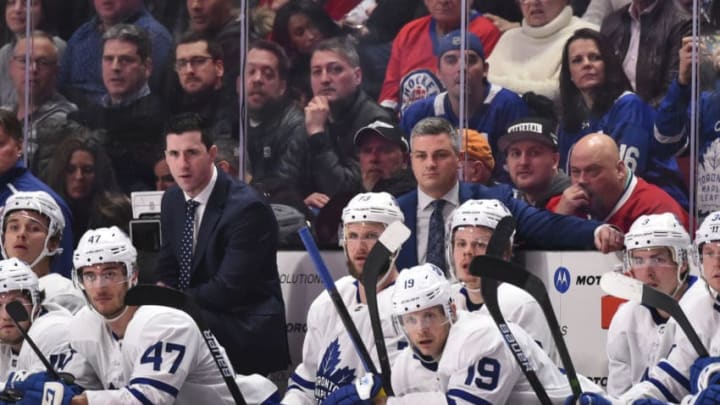The Toronto Maple Leafs are set to take on the Columbus Blue Jackets in the Stanley Cup Qualifiers, with Game 1 on Sunday, August 2, 2020.
For a team full of as much offensive talent as the Toronto Maple Leafs, it would seem easy to structure their game plan around simply scoring more than the opponents and not worrying about the rest.
However, the parity in the NHL won’t permit that basic of an approach to yield consistently successful results. Sure, we see the odd 7-5 type of score, but it’s not a sustainable strategy nor will it work against the Columbus Blue Jackets.
As much as this game has advanced throughout the different eras of the sport, there are still basic requirements necessary and exemplified throughout any winning equation that results in a Stanley Cup.
Where specific approaches differ comes from assessing a team’s strengths and weaknesses, to effectively gauge which areas require added attention. It may seem like an obvious observation, but some parts of the game don’t need to be overly complicated.
Columbus is a defensive minded team, driven by a work ethic and will to win that won’t be easy to beat. A tough challenge for an offense-first Toronto roster that should not take such opponents lightly.
These are the most vital areas for the Maple Leafs to focus on, if they expect to beat the Blue Jackets and move any closer towards a Stanley Cup.
Mid-Season Form Goaltending
Frederik Andersen has created a less than ideal pattern of his play in recent years, when it comes to expectations of what fans will see of him after a long stretch of time away from the rink.
Simply stated, he’s been a slow starter when schedules get underway. His October numbers being drastically worse than those he achieves through November over the past few seasons are an illustration.
With the time off from the NHL’s pause to the beginning of this post-season, many are understandably anxious at seeing which version of Andersen his Maple Leafs team can expect in their crease.
Playing the full duration of their exhibition game against the Montreal Canadiens, Andersen saved 28 of 30 shots, achieved a .933 save percentage, and earned the win. He looked solid the whole way.
https://twitter.com/MapleLeafs/status/1288312125534998530?s=20
Toronto needs that type of mid-season performance from their netminder throughout every game of their upcoming best-of-5 against the Blue Jackets.
Success on Special Teams
The Maple Leafs season saw them earn a 23.1% conversion rate on the power play, which was good enough to rank in 6th overall throughout the entire league. However, their penalty kill of 77.7% was far less effective and landed them all the way down in 21st.
With the type of scoring power they have in spades and the uncertainly around their defensive side of the game, these placements align perfectly to paint the bigger picture of their season.
These results just aren’t good enough if they expect to put up the type of fight that’ll be necessary to move beyond the Blue Jackets and past the qualifiers. Both sets of systems need to be better.
In their tune-up game versus the Canadiens, they completely flipped their own script. They saved their special teams scoring for their penalty kill, netting two through four shorthanded scenarios, and went scoreless on the power play.
The @MapleLeafs scored two shorthanded goals in their exhibition game tonight.
— NHL Public Relations (@PR_NHL) July 29, 2020
The last time they scored two such goals in a single game was Oct. 30, 2013. #NHLStats #StanleyCup https://t.co/D6qCMftqDQ pic.twitter.com/9pPaxCJVi5
Toronto will have to create their own pressure to produce in these situations, continuing to score with the extra advantage while shutting things down during the times they’ve shown they typically don’t.
Simplified Defensive Structures
Even with leaders like Morgan Rielly, up and comers like Travis Dermott, and newer additions like Jake Muzzin, one of the more common storylines of this organization is their need to tighten things up behind their power upfront.
It’s fair to say that any good team can effectively defend and protect their own zone. As much as they all need to score goals at the other end, keeping pucks out of their own net clearly matters too.
For as much producing as the Maple Leafs do, it’s no surprise when their back end looks to get involved in making that next offensive play. That needs to become less of their norm, with a shift to focusing on steadiness in the role.
Rielly scored shorthanded against Montreal in a timely situation that permitted that type of play. Letting in the 7th most goals across the league, Toronto’s defense should only look to get on the board when it isn’t a liability to do so.
"Overall I think it was about us having good effort, good habits and I thought for the most part we did that."
— Toronto Maple Leafs (@MapleLeafs) July 29, 2020
🎥 Post-game media mashup | #LeafsForever pic.twitter.com/c3GMjolqRc
These players need to make defending their primary goal. The Toronto Maple Leafs will then be positioned to do more damage where it’s needed, as opposed to fixing mistakes made from failed attempts.
A best-of-5 series doesn’t allow for much room to rebound from errors. The Toronto Maple Leafs need to come out fine tuned and ready to battle if they expect to make it beyond these Blue Jackets.
